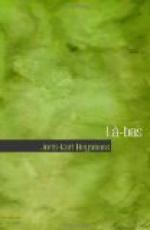But quite accessible was another part which overhung the Sevre. There the wings of the castle, overgrown with ivy and white-crested viburnum, were intact. Spongy, dry as pumice stone, silvered with lichen and gilded with moss, the towers rose entire, though from their crenelated collarettes whole blocks were blown away on windy nights.
Within, room succeeded glacial room, cut into the granite, surmounted with vaulted roofs, and as close as the hold of a ship. Then by spiral stairways one descended into similar chambers, joined by cellar passageways into the walls of which were dug deep niches and lairs of unknown utility.
Beneath, those corridors, so narrow that two persons could not walk along them abreast, descended at a gentle slope, and bifurcated so that there was a labyrinth of lanes, leading to veritable cells, on the walls of which the nitre scintillated in the light of the lantern like steel mica or twinkling grains of sugar. In the cells above, in the dungeons beneath, one stumbled over rifts of hard earth, in the centre or in a corner of which yawned now the mouth of an unsealed oubliette, now a well.
Finally, at the summit of one of the towers, that at the left as one entered, there was a roofed gallery running parallel to a circular foothold cut from the rock. There, without doubt, the men-at-arms had been stationed to fire on their assailants through wide loopholes opening overhead and underfoot. In this gallery the voice, even the lowest, followed the curving walls and could be heard all around the circuit.
Briefly, the exterior of the castle revealed a fortified place built to stand long sieges, and the dismantled interior made one think of a prison in which flesh, mildewed by the moisture, must rot in a few months. Out in the open air again, one felt a sensation of well-being, of relief, which one lost on traversing the ruins of the isolated chapel and penetrating, by a cellar door, to the crypt below.
This chapel, low, squat, its vaulted roof upheld by massive columns on whose capitals lozenges and bishop’s croziers were carved, dated from the eleventh century. The altar stone survived intact. Brackish daylight, which seemed to have been filtered through layers of horn, came in at the openings, hardly lighting the shadowed, begrimed walls and the earth floor, which too was pierced by the entrance to an oubliette or by a well shaft.
In the evening after dinner he had often climbed up on the embankment and followed the cracked walls of the ruins. On bright nights one part of the castle was thrown back into shadow, and the other, by contrast, stood forth, washed in silver and blue, as if rubbed with mercurial lusters, above the Sevre, along whose surface streaks of moonlight darted like the backs of fishes. The silence was overpowering. After nine o’clock not a dog, not a soul. He would return to the poor chamber of the inn, where an old woman, in black, wearing the cornet head-dress her ancestors wore in the sixteenth century, waited with a candle to bar the door as soon as he returned.




